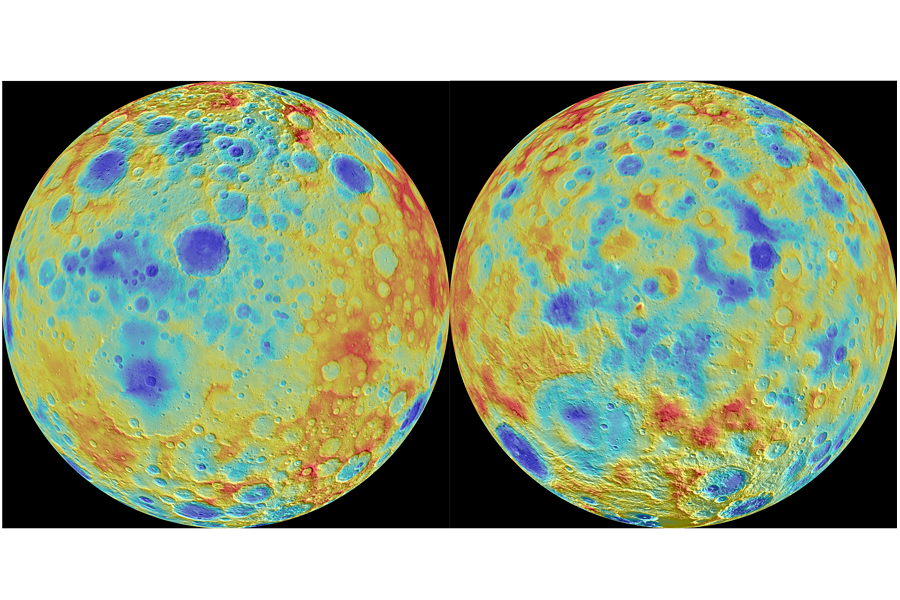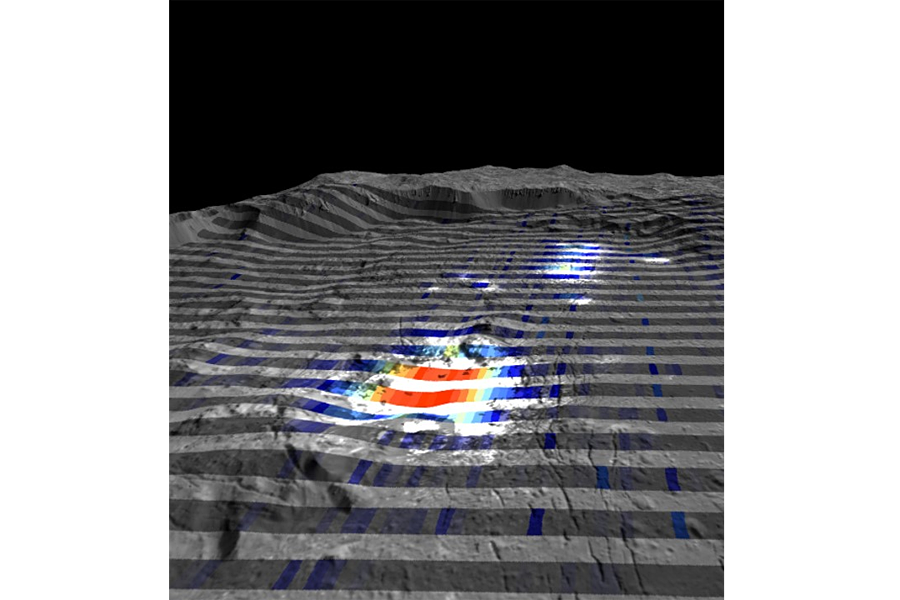Dwarf planet Ceres may be less icy, more complex, say scientists
Before NASA's Dawn spacecraft arrived at Ceres in 2015, the queen of the asteroid belt was considered to be a boring, ice-rich space rock. But now a more complex, dynamic world is coming into view.
Most scientists thought the dwarf planet (sometimes characterized as an asteroid) had a rocky core covered by a layer of fairly pure water-ice, with a rocky topping. But new data from Dawn suggests that Ceres's composition might not be such a simple water-ice sandwich.
In fact, that supposedly ice-rich layer of Ceres is probably not as icy as originally thought, according to a new study published Wednesday in the journal Nature Geoscience. And the sandwich analogy might not be so fitting, as the subsurface of Ceres is likely more of an uneven mix of rock, ice, salts, and other minerals.
That's not all. Bright spots associated with the large Occator impact crater on the surface of Ceres are highly reflective thanks to a variety of salts, according to another paper published Wednesday in the journal Nature. And those minerals were not deposited by the space rock that created the crater, the team says. Instead, they appeared on the surface of the crater later, likely through a water-related process.
"It's frustrating to me professionally that people have thought of Ceres as being kind of a boring sphere," Amy Lovell, an astronomer at Agnes Scott College in Decatur, Ga. who was not part of either study, tells The Christian Science Monitor in a phone interview. Both of these new studies suggest Ceres is a "really interesting object" worthy of more study, she says.
Not so icy after all
Ceres is pockmarked with impact craters, but those humongous holes don't look like they should, according to the ice-rich model of the dwarf planet.
Water-ice can flow, if slowly. So scientists expected the older impact craters to be shallower, or even erased, by the viscous flow of an ice-rich subsurface layer on Ceres. But the old craters are very deep, with almost all of the largest ones reaching well over a mile into the dwarf planet's surface.
"That's not consistent with this very pure ice subsurface composition," Michael Bland, lead author of the Nature Geosciences paper and a research scientist at the USGS Astrogeology Science Center and Washington University in St. Louis, tells the Monitor in a phone interview.
Furthermore, the craters around the equator of Ceres should be shallower than at the poles, as warmer temperatures should help the ice flow more easily, Dr. Bland explains. But "this just isn't the case," he says. "We see deep craters all over Ceres, and we see many deep craters."
So Bland and his team made models of Ceres's craters and the viscous flow of an icy subsurface.
The result? "We suggest that you must not have more than about 30 or 40 percent water-ice by volume in Ceres's interior, because if you had more than that, then the ice would be able to flow too easily and it would erase the topography," Bland explains.
But there's a catch.
"We know that Ceres has a very low density, a density right between ice and rock," he says. If the amount of ice is lower than previously thought, then, the rest can't simply be rock: that would make the models too dense to match Ceres.
"So there must be other kinds of low-density things in its interior," he says, such as salts or other minerals.
And "there may be a large inventory of salts on Ceres' surface," Julie Castillo-Rogez, a co-author on both papers and a planetary scientist at the California Institute of Technology and NASA's Jet Propulsion Laboratory working on the Dawn mission, tells the Monitor in a phone interview. "And all together they could contribute to strengthening the shell."
But, she adds, "We need to pin down the density of Ceres's shell in order to test which salts are most likely."
Fortunately, the other study examines some of the salts found on Ceres.
Salty bright spots
Several hypotheses had been proposed to explain the strange bright patches that appeared in impact craters in Dawn's images of Ceres. Some scientists suggested that chunks of water ice were reflecting light, while others said salts, particularly sulphates, could give the same appearance.
But "water ice is not present (at least at the resolution that we have)," Maria Cristina De Sanctis, lead author of the Nature paper and a researcher at the Institute for Space Astrophysics and Planetology at the National Institute for Astrophysics in Rome, writes in an email to the Monitor. And "sulphates are not there. Instead carbonates are the main constituent of such bright material."
Dr. De Sanctis and her colleagues studied spectral data from Dawn to take a closer look at the bright spots in the Occator crater on Ceres. They found that this region is quite salty and is largely made up of sodium carbonate, which Dr. Castillo-Rogez says is "a very strong signature of a past ocean on Ceres."
"The huge amount of carbonates indicates that liquid water was present at Ceres subsurface … some time in the recent past," De Sanctis says.
These salts are highly soluble and "the geology of the deposit – specifically, spatial relationships with the surroundings – indicates that the carbonates came to the surface after the crater formed," Bethany Ehlmann, a co-author on the Nature paper and a planetary scientist at the California Institute of Technology and NASA's Jet Propulsion Laboratory, tells the Monitor in an email.
So the scientists suggest that water carried the carbonates to the surface in the impact crater before evaporating and depositing the salts in their bright displays.
But it's about negative 170 degrees Fahrenheit at the equator of Ceres, so how could H2O have been a liquid?
Perhaps the heat of the impact melted some of the ice within Ceres, the authors suggest, or maybe it's warm enough inside the dwarf planet for liquid water to exist.
And the variety of salts on Ceres could have helped too. Salts can significantly depress the freezing point of water, Castillo-Rogez explains. Some salt and water mixtures can still be liquid at temperatures as low as negative 112 degrees Fahrenheit, she says, although that's "a bit extreme. But let's say that the freezing point is depressed [to] -21 degrees C [-5.8 degrees Fahrenheit], then this is consistent with temperatures predicted for Ceres's deep interior at present."
"Hence there could be a bit of melt remaining in Ceres today," Castillo-Rogez says.
Puzzle pieces
The two papers both raise questions about the composition of Ceres. "They're two pieces to the same puzzle," Bland says, "But we haven't seen the whole picture yet."
"In planetary science, as you investigate an object, you have to think about everything at once," Dr. Lovell says. The mineralogy of the surface of Ceres and the crater depth could be related, she says, but possibly through another variable that has yet to be discovered.
"I expect it to be complicated," she says. In the jigsaw puzzle of understanding Ceres, "these may not be adjacent pieces."
Regardless, knowing more about the composition of the largest object in the asteroid belt can give scientists clues into more of the Solar System.
Because Ceres is particularly icy for being in the middle of the Solar System, scientists have suggested that it may have formed farther out, among the colder, outer planets. It may have been a moon of Jupiter or Saturn, for instance, knocked out of orbit by a passing comet.
But perhaps the dwarf planet did form where it is today and was somehow able to hold onto its ice, Bland suggests.
And if Ceres formed in the asteroid belt, where it reigns as the largest celestial body today, it could hold insights into the process of planetary formation. "It's probably one of the building blocks of what turns into a planet," Lovell says.
Overall, seeing Ceres as a more complex, geologically active world hints at activity more broadly.
"These results are exciting because it suggests the asteroid belt is not just a cold, dead place," Dr. Ehlmann says. "It is dynamic."







